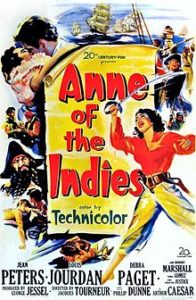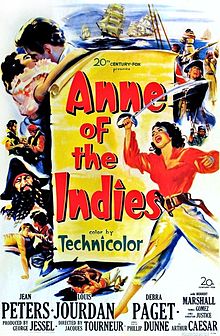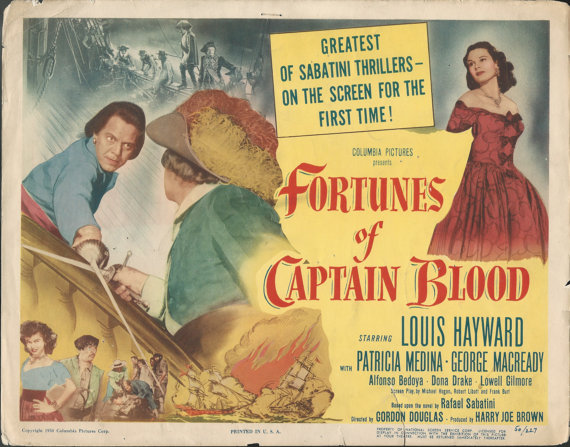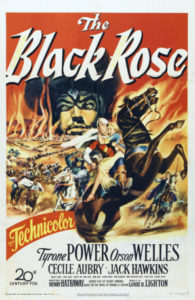ELLSWORTH’S CINEMA OF SWORDS: 1951
Anne of the Indies
Rating: ****
Origin: USA
Director: Jacques Tourneur
Source: Amazon Streaming Video
 We usually award the title Queen of the Swashbucklers to Maureen O’Hara, but Jean Peters makes a grab for her crown in this fine pirate melodrama. As an orphan girl, Anne (Peters) was raised aboard ship by Edward Teach—Blackbeard himself!—and now commands her own ship, the Sheba Queen, under the name Captain Providence. Since her brother was hanged as a pirate by the English, she preys on English shipping and kills English sailors without mercy, making the captives walk the plank. But one of these captured sailors is the strikingly-handsome Louis Jourdan playing a Frenchman named (what else?) François, who claims to be a privateer’s navigator who’d been captured by the Royal Navy. Captain Providence frees him, adds him to her crew, and takes him to Nassau to meet Blackbeard—which is where the real trouble starts.
We usually award the title Queen of the Swashbucklers to Maureen O’Hara, but Jean Peters makes a grab for her crown in this fine pirate melodrama. As an orphan girl, Anne (Peters) was raised aboard ship by Edward Teach—Blackbeard himself!—and now commands her own ship, the Sheba Queen, under the name Captain Providence. Since her brother was hanged as a pirate by the English, she preys on English shipping and kills English sailors without mercy, making the captives walk the plank. But one of these captured sailors is the strikingly-handsome Louis Jourdan playing a Frenchman named (what else?) François, who claims to be a privateer’s navigator who’d been captured by the Royal Navy. Captain Providence frees him, adds him to her crew, and takes him to Nassau to meet Blackbeard—which is where the real trouble starts.
This story as originally developed was supposed to be about historical female pirate Anne Bonny, but then Hollywood happened and History was shown the door. But the story we got instead, a nautical love triangle punctuated by sword fights and naval actions, is perfectly fine, with the seeds of tragedy planted in the first act bearing woeful but believable fruit in the last. And History didn’t entirely get the boot, as somebody did their research into the Age of Sail, and for once they got all the details impressively right. The sailing orders the officers bark out are accurate and appropriate, the gun crews serving the cannons follow authentic routines instead of just miming, and we get the rarely-seen spectacle of a ship careened on her side on the beach of a hidden cove, as her crew use their boarding axes to clear the barnacles from her foul bottom. Nice!
We also get brief but spot-on looks at three Caribbean ports: the brawling pirate hell of Nassau, the private club of the perfidious officers of the Royal Navy in Port Royal, and the exotic mix of traders and sailors from every sea at the slave market in the Spanish town of Maracaibo. During all this sailing around in pursuit of the plot, Jean Peters stays in fine form as the ever-angry Captain Providence—and she can fence, too! Louis Jourdan sells it as the suave but two-faced François, and the ursine Thomas Gomez makes a memorable Blackbeard. There’s even a solid early appearance in a supporting rôle as Anne’s rival by Debra Paget. Add stylish direction by Jacques Tourneur and a rollicking soundtrack by Franz Waxman, and it makes for a tidy package o’ piracy that’s well worth seeking out, bedad!
Captain Horatio Hornblower
Rating: *****
Origin: USA
Director: Raoul Walsh
Source: Warner Bros. DVD
Drawing from three of the Hornblower novels by C.S. Forester, this movie is easily the best depiction of Napoleonic-era naval warfare until, well, the British TV Hornblower adaptations in the late ‘90s. It also works as a character study, as a romance, and an unflinching reminder of the high human cost of war. Forester himself wrote the adaptation, though the script was handled by three Hollywood screenwriters. The film was originally developed as a vehicle for Errol Flynn, but after the disappointment of The Adventures of Don Juan, Flynn was passed over, and the movie stars Gregory Peck as Royal Navy Captain Hornblower. It’s a great choice: Peck, though not English, has the sort of awkward grandeur the rôle requires, formal and severe on the surface, but gnawed by doubt underneath. Hornblower wins his battles against the odds by out-thinking his opponents, and Peck deftly conveys the character’s native intelligence. Plus, he just plain looks great in a Royal Navy captain’s rig, like a statue from the Admiralty come to life.
The story is wide-ranging, from the tropical Pacific to the cold North Atlantic, and if it has a flaw it’s over-ambition, cramming in a midnight boarding expedition, a gun duel between ships of the line, a mad warlord, a jealous commodore, imprisonment and escape, a ship hijacked from port, and a surprise attack on an anchored French squadron under the guns of a cliff-top fortress—all in just under two hours. Somehow there’s still time for character development, camaraderie among the English officers, and the mourning of losses after the battles. Credit must be given to veteran director Raoul Walsh for keeping all of these elements moving swiftly and coherently without ever feeling rushed.
And we haven’t even gotten to the romance yet! The changing politics of war mean that Lady Barbara Wellesley (Virginia Mayo) needs a sudden ride out of Panama, and Hornblower’s is the only English ship for thousands of miles, so he’s stuck with carrying her around the Horn and back to England. Lady Barbara shows courage and heart by caring for the wounded during battle, Hornblower returns the favor by personally nursing her through a bout of debilitating tropical fever, and love blooms. But they’re adults with commitments, neither one is free, and obstacles must be surmounted. Mayo, who in a lightweight part could sometimes rely on her smile and phone it in, excels herself here as Lady Barbara, showing how well she can act when she’s engaged with the rôle. That, and her genuine chemistry with Peck, really make the love story work. But of course, Forester had a feel for stories of strong women romancing eccentric captains: he also wrote The African Queen. By the way, watch for Christopher Lee as a Spanish captain fighting a fierce cutlass duel with Hornblower—he’s the only guy in the movie who’s taller than Gregory Peck.
The Magic Carpet
Rating: *
Origin: USA
Director: Lew Landers
Source: Amazon Streaming Video
This is quite terrible. In a cheesier-than-usual Arabian palace set, the Good Caliph is just naming his newborn son his sole heir when he’s assassinated by the New Evil Caliph. The nurse escapes with the child and sends him flying away on a magic carpet. (This is the only fantasy element in the film and is completely unexplained, because Mysterious East or something.) The child is taken to a doctor, who hides the carpet and decides to raise the child as his own, not telling him that he’s the Rightful Caliph. The child grows up to be legendarily-bad leading man John Agar, who has all the screen presence and charisma of an Idaho potato. There’s a guards-oppressing-the-people montage; Agar, now called Dr. Ramoth, sees some oppressing and says some lines to show he disapproves, thought that’s the only way you can tell because his face doesn’t change. To fight the Evil Caliph’s oppression Dr. Ramoth becomes the Scarlet, or maybe Crimson Falcon, and leads a band of freedom fighters in a freedom-fighting montage. He keeps raiding the wrong caravans that don’t have the weapons he needs to arm the people to overthrow the Evil Caliph, so Agar decides he needs to infiltrate the palace to get inside information. His cunning plan is to kill a bunch of palace guards so he can get his comic sidekick inside, where he can take the place of the Evil Caliph’s wine taster and dose him with a permanent-hiccups potion. Nobody pays any attention to the dead guards, because there are plenty of them, so Dr. Ramoth cures the Evil Caliph of permanent hiccups and becomes the new palace physician.
Yeah. Now that he’s inside the palace Agar meets the Evil Caliph’s Evil Sister, who is played by, I am not making this up, Lucille Ball. With her red hair and green eyes she’s about as Arabian as a leprechaun, but I suppose what matters is that she wears harem pants and a midriff-exposing top like the, I guess the word is bevy of giggling starlets prancing around the palace and its blue plastic in-ground pool. Cast as a seductive villainess, Ball’s talents are completely wasted as she never does anything the least bit funny or, for that matter, seductive or villainous. More stuff happens: Agar finds out he’s the Rightful Caliph and flies around on his carpet, the effects for which are so awful they’re almost endearing. There’s a bunch of “swordplay,” with lots of people waving around thin curved sticks that are supposed to represent scimitars, but confusingly there are always some guys waving actual sticks because I guess the props department didn’t make enough scimitars. Also, everybody knows that when you run someone through you pass the sword behind their body, but Raymond Burr didn’t get the memo and stabs people on the wrong side. Oh, right, he’s in this too, as the Evil Caliph’s Evil Grand Vizier, wearing black facial hair that must be pretty stiff because his lips barely move when he speaks. Only his eyes look alive, the eyes of trapped animal shifting this way and that, desperately seeking an escape.
The Prince Who was a Thief
Rating: ***
Origin: USA
Director: Rudolph Maté
Source: ATI Entertainment DVD
This is the first of many sword-swinging starring rôles for Tony Curtis, whom you really can’t avoid if you’re watching historical adventures made in the ‘50s. Everybody mocks Curtis, and it’s mostly deserved, because he just doesn’t have the wits of a Burt Lancaster, or even a Louis Hayward, but he’s not terrible so much as just mediocre. Somebody was persuaded, and persuaded him, that he was movie star material, and it took Hollywood about ten years to figure out that he was best employed as a reliable second banana. Fortunately he’s offset in this film by engaging performances from Everett Sloane and from Piper Laurie, who even this early in her career knew exactly what she was doing.
As in The Prince of Foxes, Sloane excels playing a thief and assassin, though here with a comic touch he didn’t get a chance to show in the earlier film. Hired to kill the infant Dey of Tangier so the child’s wicked uncle can assume the throne, when the time comes he can’t do it, so he fakes the murder and takes the child to raise as his own. As in all these tales of a rightful monarch raised by someone else, we know how it’s going to end, so the pleasures or disappointments come in the getting from here to there. This time the trip is mostly worthwhile. The boy grows up to become Julna (Tony Curtis), the city’s greatest thief, who is fixated on its greatest prize, the treasury vault where the false dey stores the gold his tax collectors wrest from the people. The business of thieving gets a proper workout in this movie, and Julna’s exploits evoke the young Conan the Barbarian, or a Dungeons & Dragons rogue. The whole thing is shot on soundstages, with no exteriors at all, just the ever-dark city streets and the moody lamp-lit interiors that surround and tower over them.
In proper Thief of Bagdad fashion, while escaping some guards Julna goes where he shouldn’t and casts his eyes on forbidden fruit, his beautiful cousin the Princess Yasmin (Peggie Castle). The thief is smitten with the snotty princess, but as soon as he cute-meets another thief, Tina (Piper Laurie), during a bungled jewel robbery, we know she’s really the one for him. The barely-legal Laurie, as slippery as an eel and as cute as two bugs, is a wide-eyed naïf who speaks of herself in the third person like an Elder Scrolls Khajiit, and is just as adorably avaricious. Lissome and energetic, she effortlessly matches Curtis’s considerable athleticism, usually while squealing with glee. She’s a delight.
Though based on a story by Theodore Dreiser, of all people, the plot is standard-issue claptrap, with mistaken identities, intrigue in the dey’s court, and an egg-sized pearl the possession of which is the key to marrying the snotty princess. There are several unnecessary scenes of “oriental” dancing by scantily-clad women, but to be fair there’s also a lot of gratuitous swimming by the bare-chested Curtis. There are gags interspersed between the thefts and pursuits, but about half of them fall flat, often because they rely on labored locutions such as, “Begone, you sons of she-camels!” Still, the scene where the thieves use geese as projectiles is charming. In the end, Julna is revealed as the Rightful Dey—he has a tattoo AND a scar, to make doubly sure—the snotty princess is cked off, and Tina is forced to take a bath so she can be properly married. Ending in a marriage: that’s what makes it a comedy, right?


 This movie works well as a spectacle depicting 13th-century England and parts of Mongolia and China. As an adventure or character-driven story, however, it’s not so good. This is one of those films in which the angry and stubborn protagonist is told at the beginning what he needs to do to find peace and purpose, spends the next two hours determinedly rejecting that advice, before finally embracing it in the last ten minutes of the picture. Lame! In this case, Walter of Gurnie (Tyrone Power), an illegitimate son of a Saxon lord, is the angry protagonist who’s suffered injustice at the hands of his Norman relatives. Edward II (Michael Rennie)—the King of England, no less—tells Walter he needs to put aside his hatred of the Normans for his own good and that of the realm and its people, but Walter angrily insists on leaving England to seek his fortune in distant lands—in far Cathay, if necessary, which he heard about from his Oxford mentor, Roger Bacon.
This movie works well as a spectacle depicting 13th-century England and parts of Mongolia and China. As an adventure or character-driven story, however, it’s not so good. This is one of those films in which the angry and stubborn protagonist is told at the beginning what he needs to do to find peace and purpose, spends the next two hours determinedly rejecting that advice, before finally embracing it in the last ten minutes of the picture. Lame! In this case, Walter of Gurnie (Tyrone Power), an illegitimate son of a Saxon lord, is the angry protagonist who’s suffered injustice at the hands of his Norman relatives. Edward II (Michael Rennie)—the King of England, no less—tells Walter he needs to put aside his hatred of the Normans for his own good and that of the realm and its people, but Walter angrily insists on leaving England to seek his fortune in distant lands—in far Cathay, if necessary, which he heard about from his Oxford mentor, Roger Bacon.